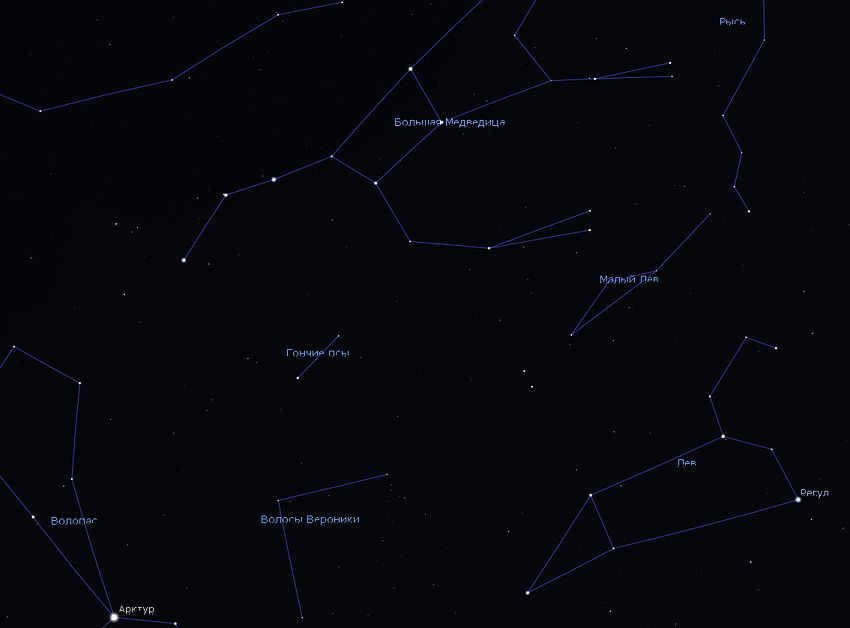The Great Dipper is undoubtedly the most well-known formation in our celestial sphere. It has gained its popularity due to its distinct shape, memorability, significant brightness, and, most importantly, its constant presence above the horizon in our latitudes. In other words, the dipper is perfectly suited to serve as a guide to other constellations and prominent stars. Its effectiveness in this role is especially evident during the spring season, when it can be found near the zenith in the evening sky.
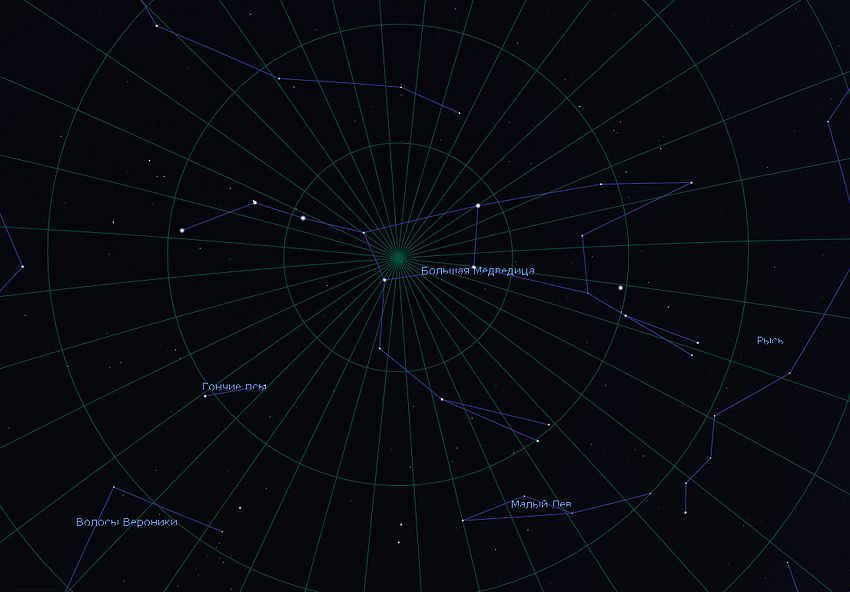
The Big Dipper can be seen at its highest point in the evening sky during the spring season. Image: Stellarium
For those who are just starting to learn about the stars, it is important to note that the Big Dipper is not in the same position during the spring evenings as it is in the fall and winter! In the autumn, the dipper can be found low above the northern horizon, with its shape resembling a classic horizontal position. However, in early spring, as darkness falls, the dipper can be seen in the northeast with the handle pointing upwards, and by mid-spring, it will be directly overhead! If you observe the dipper at its highest point while facing north, it will appear upside down. Because of these changes, some newcomers may have difficulty recognizing the dipper in the spring sky.
However, when spring arrives, the Big Dipper fulfills its purpose as a celestial guide. Let’s briefly explore the stars and constellations that can be located in the spring sky with its assistance.
Polaris
The renowned Polaris can be easily pinpointed using the two outer stars of the Big Dipper, Dubhe and Merak, which are sometimes referred to as the Pointers. To accomplish this, trace a line from Merak to Dubhe, and extend it further by multiplying the distance from Merak to Dubhe by five. At the end of this line, you will observe a star of similar brightness to the pointer stars. That star is Polaris!
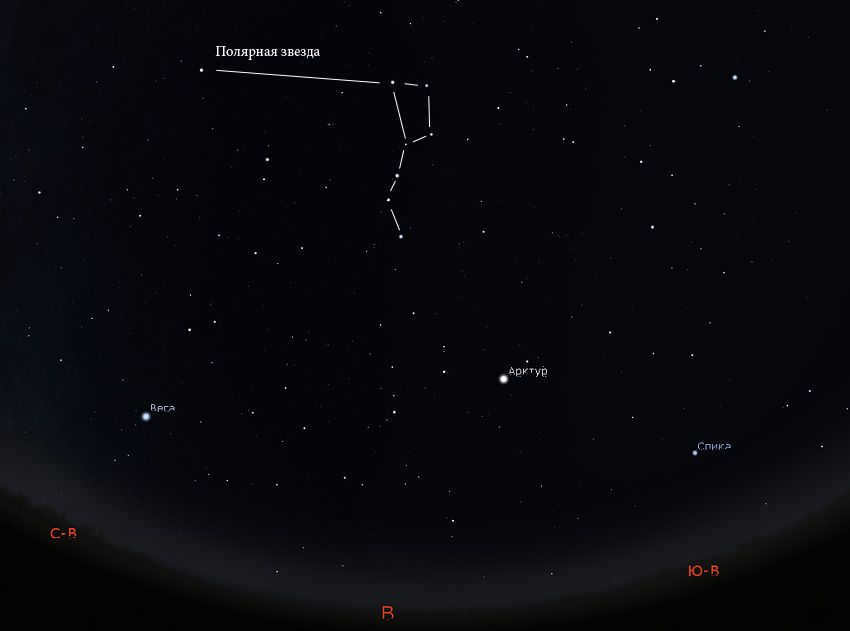

Locating Polaris with the Big Dipper is a fairly simple task. Figure: Stellarium
Take note: Polaris remains fixed in its position and does not move. It is the other stars that revolve around it, tracing concentric circles throughout the day and an additional circle over the course of a year.
Capella
A brilliant celestial body known as Capella serves as the focal point of the winter sky. From December through February, it radiates its luminosity in the evenings, positioned almost directly overhead and dominating the stunning display of winter constellations. As spring arrives, most of the winter constellations disappear below the horizon, but Capella continues to shine in the western sky. It can also be easily located by following the stars of the Big Dipper. To do this, simply draw a line from the star Megrez, located at the base of the handle, to Dubhe, the upper right star in the dipper itself. If you extend this line further, past Dubhe, the first truly brilliant star you will encounter is Capella.
Capella, in temperate latitudes, is similar to other non-setting stars such as the Big Dipper or Polaris. During the summer, Capella can be seen low above the northern horizon. However, during the white night season, it may not appear very impressive against the glowing dawn. Nevertheless, using the aforementioned method will help you easily identify Capella in a bright sky.
The Leo constellation
The Leo constellation, specifically the trapezoid shape within it, is the most striking feature in the evening sky during the months of March and April. It is located below the Ursa Major constellation, which is situated in the southern part of the sky.
If you come across a trapezoid formation in the spring sky, take note: if the Ursa Major constellation appears directly above it in the zenith, you have successfully identified the Leo constellation! (Hint: the stars within the trapezoid have a similar brightness to the stars within the Big Dipper.)
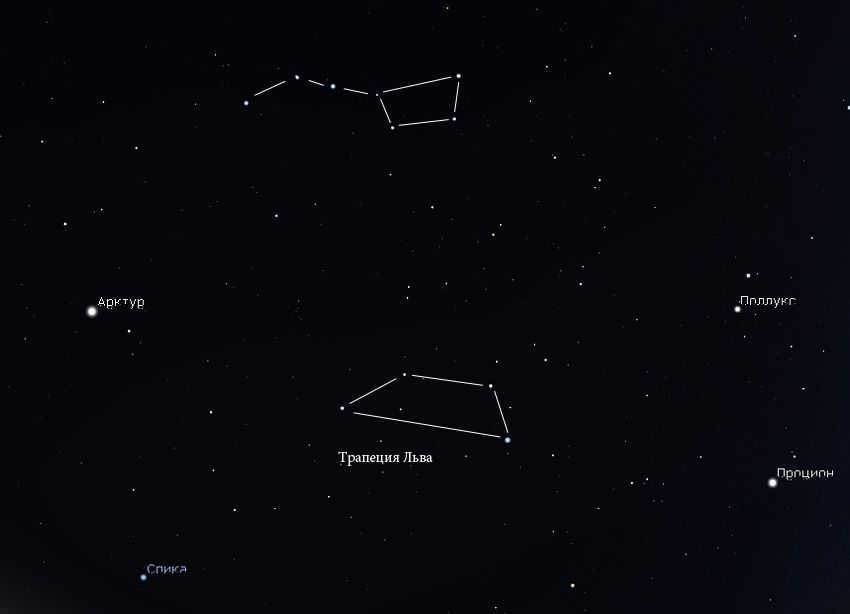
The Lion trapezoid can be found below the Big Dipper in the spring sky. Image: Stellarium
Leo constellation serves as a helpful guide to locate the faint and less prominent constellations of the Bowl, Raven, Hydra, Sextant, and others in the spring sky. These constellations are best observed in areas with minimal light pollution.
Arcturus and Spica
If the Big Dipper is facing Capella, another bright star, Arcturus, can be found by following the handle of the dipper.
It is likely that you have observed that the handle of the Big Dipper is not straight, but rather jagged. This jagged appearance is due to the presence of the famous Mizar-Alcor pair of stars, which form a physically connected double system. By extending the end of the handle even further, it will lead you to a bright orange star known as Arcturus, which happens to be the brightest star in the spring sky.
If you envision a smooth arc extending from the base of the handle, through the tip, and onward to Arcturus, you will notice a bluish star as you continue extending south. This star, located low above the horizon and likely to twinkle, is called Spica.
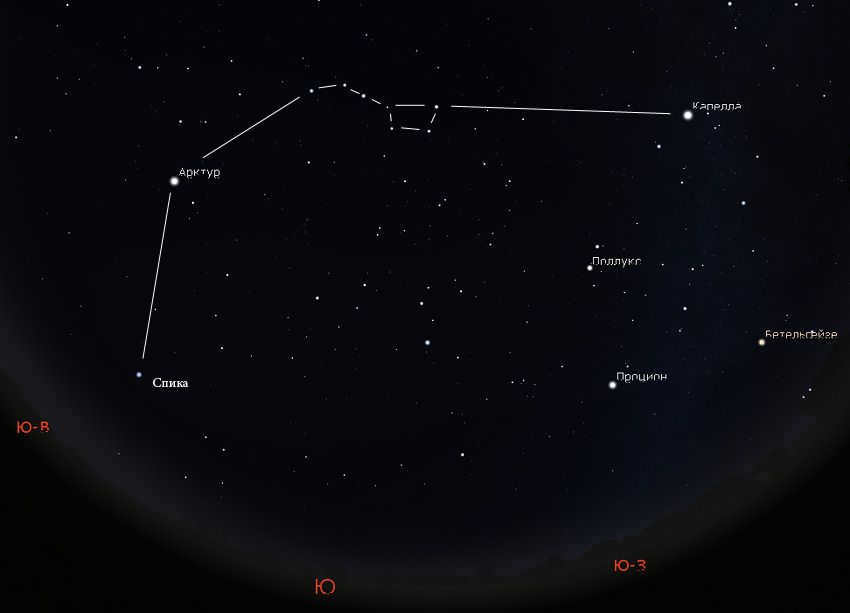

The luminous stars Arcturus and Spica can be found along an extension of the handle of the Big Dipper, while Capella is positioned in close proximity to the dipper itself. Illustration: Stellarium
Arcturus serves as the principal star of the constellation Volopassus, while Spica takes the lead in the zodiacal constellation Virgo. These two stars are the most prominent ones in the springtime sky.
The Canine Constellation
Allow me to bring your focus to a modest and unassuming constellation known as the Hound Dogs. This particular constellation can be found just below the handle of the bucket. When observed from within urban areas, the Hound Dogs appear as merely two stars. One of these stars shines with a brightness similar to that of the bucket stars, while the other emits a slightly dimmer light.
